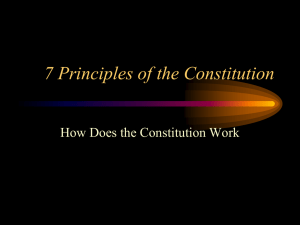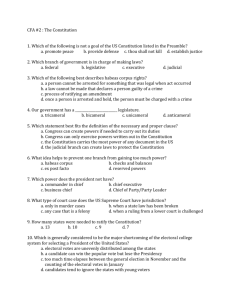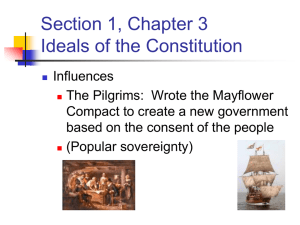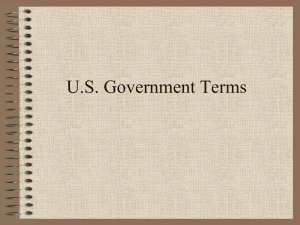7 principles metaphors
advertisement
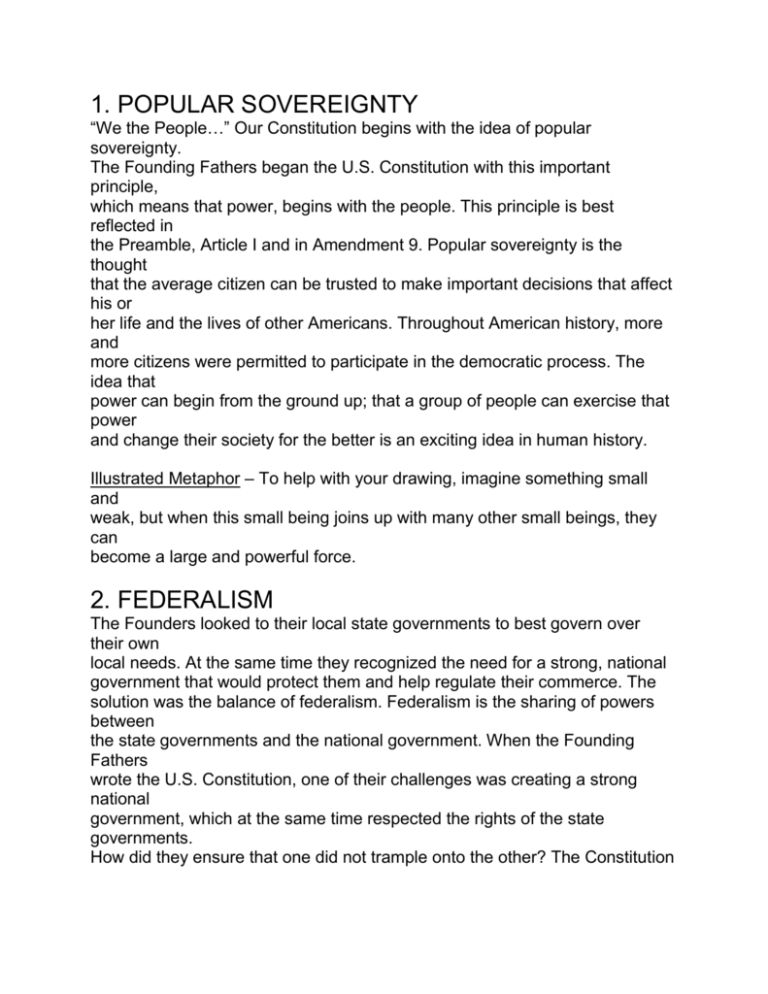
1. POPULAR SOVEREIGNTY “We the People…” Our Constitution begins with the idea of popular sovereignty. The Founding Fathers began the U.S. Constitution with this important principle, which means that power, begins with the people. This principle is best reflected in the Preamble, Article I and in Amendment 9. Popular sovereignty is the thought that the average citizen can be trusted to make important decisions that affect his or her life and the lives of other Americans. Throughout American history, more and more citizens were permitted to participate in the democratic process. The idea that power can begin from the ground up; that a group of people can exercise that power and change their society for the better is an exciting idea in human history. Illustrated Metaphor – To help with your drawing, imagine something small and weak, but when this small being joins up with many other small beings, they can become a large and powerful force. 2. FEDERALISM The Founders looked to their local state governments to best govern over their own local needs. At the same time they recognized the need for a strong, national government that would protect them and help regulate their commerce. The solution was the balance of federalism. Federalism is the sharing of powers between the state governments and the national government. When the Founding Fathers wrote the U.S. Constitution, one of their challenges was creating a strong national government, which at the same time respected the rights of the state governments. How did they ensure that one did not trample onto the other? The Constitution states that the federal government has specific powers such as coining money or defending the country. At the same time, the state governments also have powers that are reserved to them, such as creating schools. Finally there are powers they share such as the power to tax. Illustrated Metaphor - To help with your drawing, imagine two separate, different objects that still share something in the middle. 3. REPUBLICANISM Another idea that the Framers of the Constitution agreed upon was the idea that citizens should be able to elect their leaders. In a republic, the citizens vote for what or whom they think will be best for the general public good. This principle of the Constitution is not to be confused with the Republican political party, which shares a similar name. To help you remember what republicanism means, take the first 3 letters of the word, R-E-P and use it to remind yourself of the word REPRESENTATIVE. Voters choose representatives to exercise the power that they give to them. Republicanism is best found in the Preamble and in Article I of the Constitution. Illustrated Metaphor – To help with your drawing, imagine someone temporarily handing over power to someone else. They are to be trusted to make decisions for the general good of all. 4. SEPARATION OF POWERS This principle of the U.S. Constitution divides powers into three separate groups or branches of government. The reason the Framers chose this was because they wanted to ensure that no one person or group of people had too much power. Their idea originated from the way the English government had developed into three separate groups: the monarchy, the House of Lords and the House of Commons. Instead the U.S. Constitution divides power into the executive branch, the legislative branch and the judicial branch. Each branch has its own unique responsibilities and powers, including powers over the other branches. These branches are described in Articles I, II and III. Illustrated Metaphor – To help with your drawing, imagine something that has three different parts, each with its own unique characteristics, yet still a part of the whole. 5. CHECKS & BALANCES This principle of the Constitution is closely connected with Separation of Powers. The Founding Fathers wanted to make sure that the three different branches of government, the legislative, executive and judicial, would be able to limit eachother’s powers. In this way they control certain powers as well as share other powers with them. For example, the President can appoint ambassadors or federal judges, but only with the approval of the Senate, the upper house of Congress. You will find the principle of Checks & Balances throughout Articles I, II, and III. This is a very important way to protect the citizens’ liberties and ensure that no one group of people becomes too powerful. Each branch always has the other two branches looking over their shoulder. Illustrated Metaphor - To help with your drawing, imagine a product or process that doesn’t work unless several keys are turned or buttons are pushed, each being a separate branch checking the powers of the other. Or imagine a person or animal that starts something but is quickly put back into line by another person or animal. 6. LIMITED GOVERNMENT The idea of Limited Government can be traced in English history back to the Magna Carta, when the nobles first restricted the power of the king in 1215. When the Founding Fathers wrote the U.S. Constitution they recognized the need to express that the government’s powers were limited. Government leaders could not abuse their powers; they were not above the law. This was an important step in ensuring that the citizens’ liberties were protected. The principle of Limited Government can be found in Articles I, II, III. Illustrated Metaphor - To help with your drawing, imagine something or someone that is being restricted or told no. They are not more special than everybody else 7. INDIVIDUAL RIGHTS In the Preamble of the Constitution it states “…to secure the blessings of liberty to ourselves and our posterity…” This principle guarantees that citizens possess basic rights and liberties. This idea can be traced back to Thomas Jefferson’s quote on, “life, liberty and the pursuit of happiness…” in the Declaration of Independence, borrowed from the philosopher John Locke. Locke had argued that all human beings were born with three natural rights, life, liberty and property and the purpose of government was to protect those rights. The Founders debated the best way to do that, but in the end, the Constitution was amended to include the protection of certain rights, which can be found in the Bill of Rights. Illustrated Metaphor – To help with your drawing, imagine something or someone who can do something because they have a permission slip.



